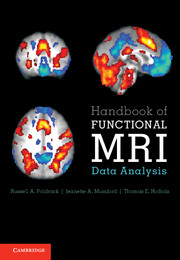Book contents
- Frontmatter
- Contents
- Preface
- 1 Introduction
- 2 Image processing basics
- 3 Preprocessing fMRI data
- 4 Spatial normalization
- 5 Statistical modeling: Single subject analysis
- 6 Statistical modeling: Group analysis
- 7 Statistical inference on images
- 8 Modeling brain connectivity
- 9 Multivoxel pattern analysis and machine learning
- 10 Visualizing, localizing, and reporting fMRI data
- Appendix A A Review of the General Linear Model
- Appendix B Data organization and management
- Appendix C Image formats
- Bibliography
- Index
Appendix C - Image formats
Published online by Cambridge University Press: 01 June 2011
- Frontmatter
- Contents
- Preface
- 1 Introduction
- 2 Image processing basics
- 3 Preprocessing fMRI data
- 4 Spatial normalization
- 5 Statistical modeling: Single subject analysis
- 6 Statistical modeling: Group analysis
- 7 Statistical inference on images
- 8 Modeling brain connectivity
- 9 Multivoxel pattern analysis and machine learning
- 10 Visualizing, localizing, and reporting fMRI data
- Appendix A A Review of the General Linear Model
- Appendix B Data organization and management
- Appendix C Image formats
- Bibliography
- Index
Summary
In the early days of fMRI, image formats were truly a Tower of Babel. Because most data were collected using research pulse sequences, the data were largely reconstructed offline and saved to file formats that varied from center to center. Because most analysis software was also written in-house, this was not a particular problem, so long as one didn't need to share data between centers. As the field developed, several standard file formats came into use, and the use of different formats between centers or laboratories was largely driven by the requirements of different analysis software packages, but until recently there still remained a substantial variety of file formats. Fortunately, the situation has gotten much better in the last decade, with the development and near-universal implementation of a common file format, known as NiFTI. In this appendix, we briefly describe some general issues regarding the storage of fMRI data along with some of the most important file formats.
Data storage
As discussed in Chapter 2, MRI data are usually stored in a binary data file as either 8-or 16-bit integers. The size of the data file on disk will thus be the product of the data size and the dimensions of the image. For example, storing a 16-bit integer image with dimensions of 128 × 128 × 96 will take up 25,165,824 bits (or 3 megabytes).
- Type
- Chapter
- Information
- Handbook of Functional MRI Data Analysis , pp. 208 - 210Publisher: Cambridge University PressPrint publication year: 2011



